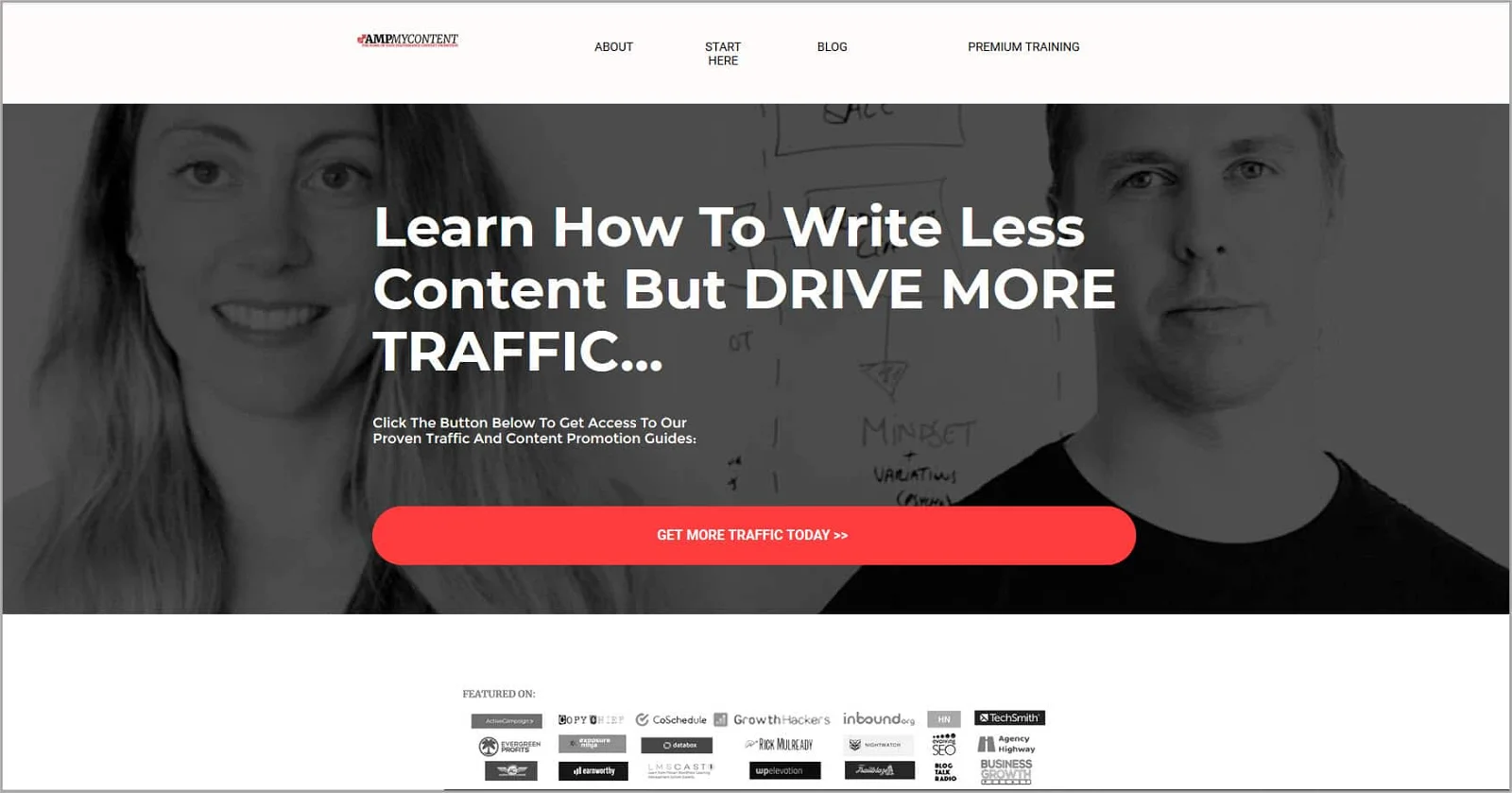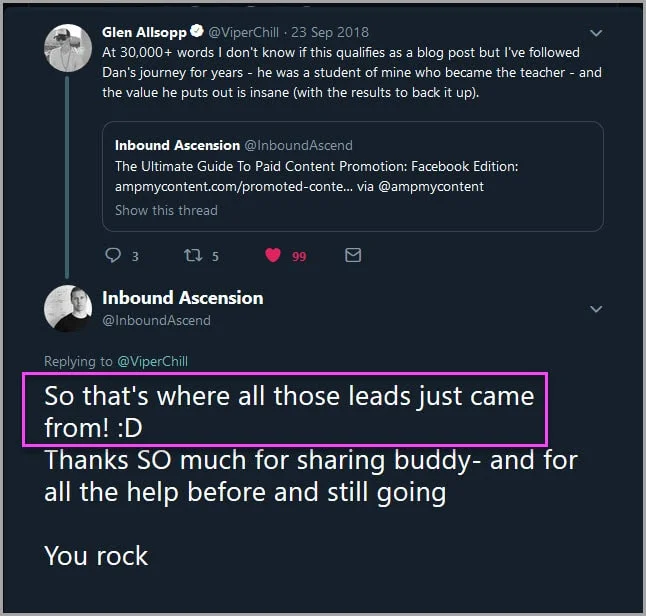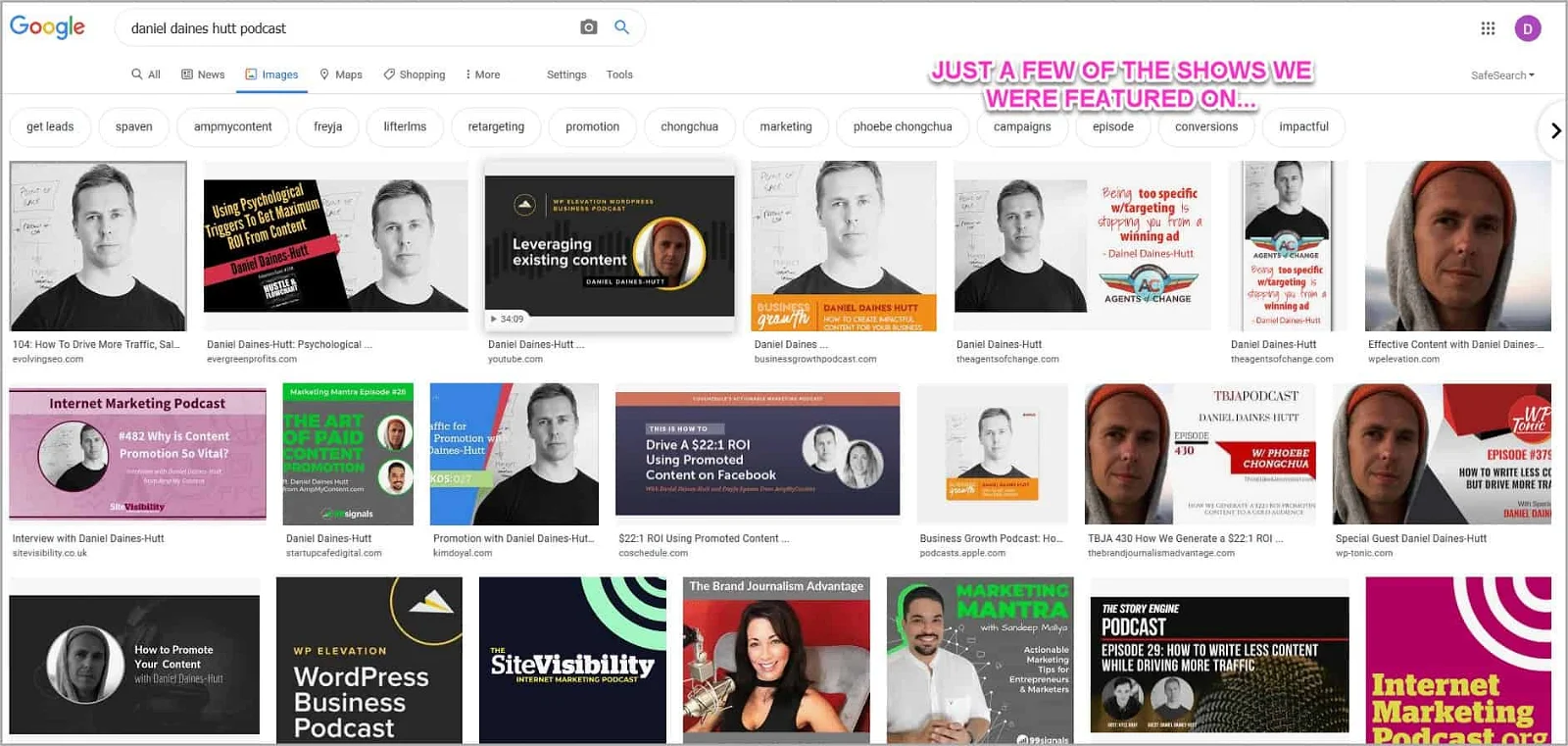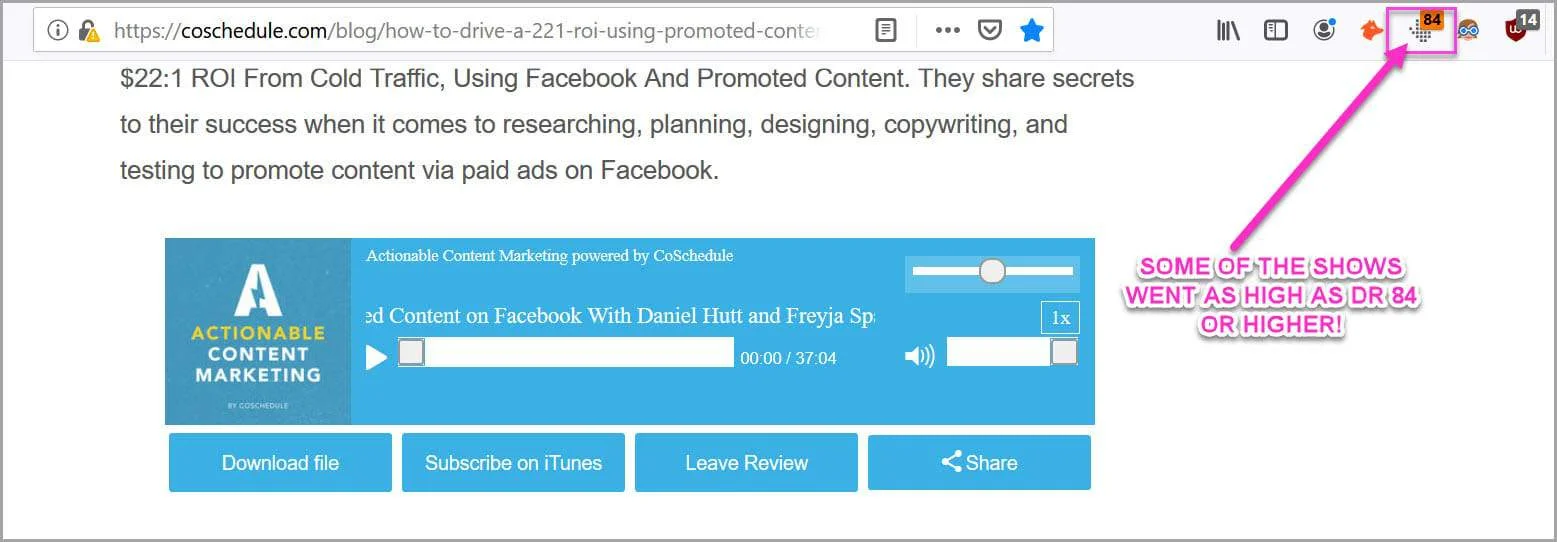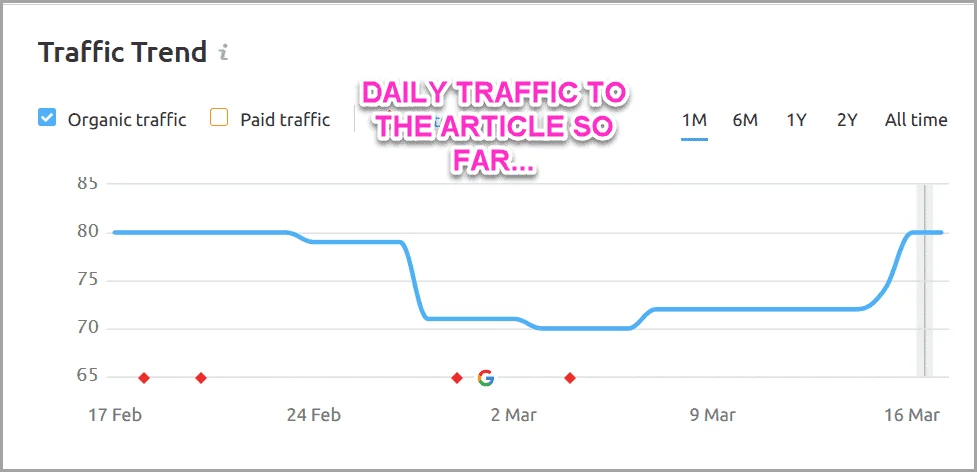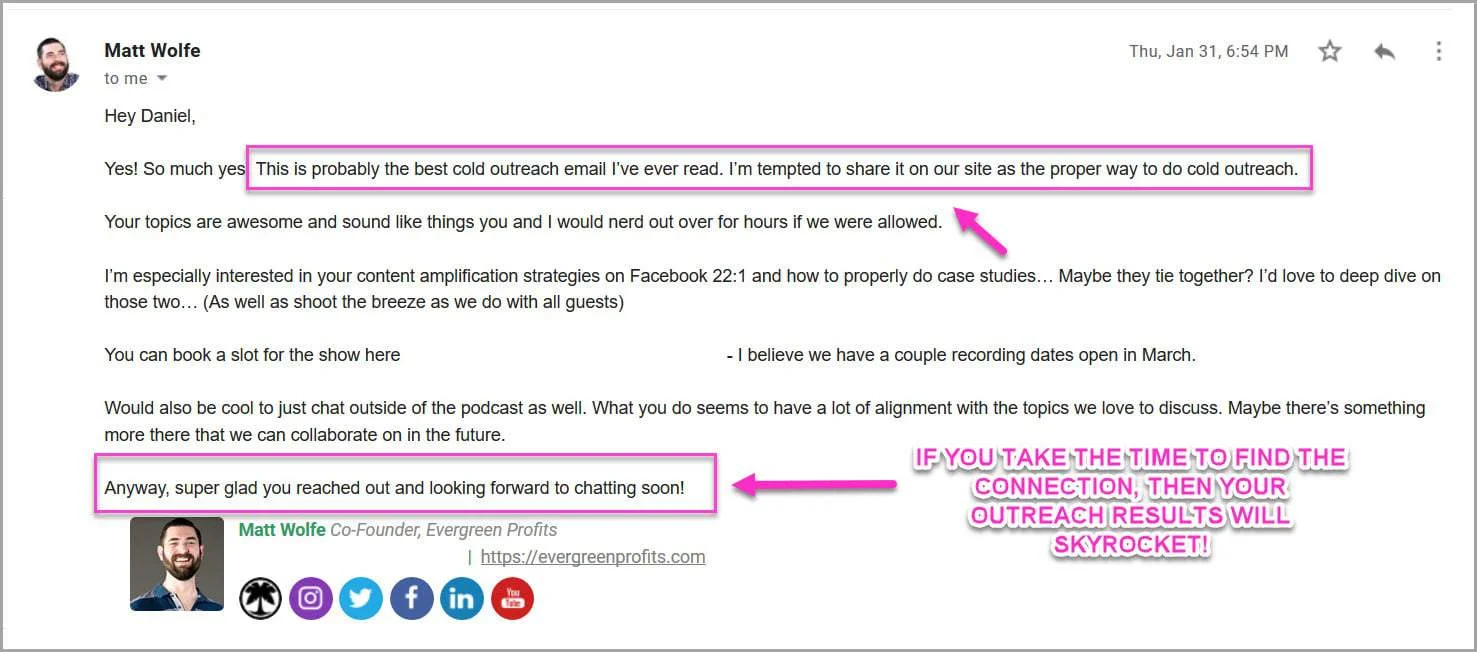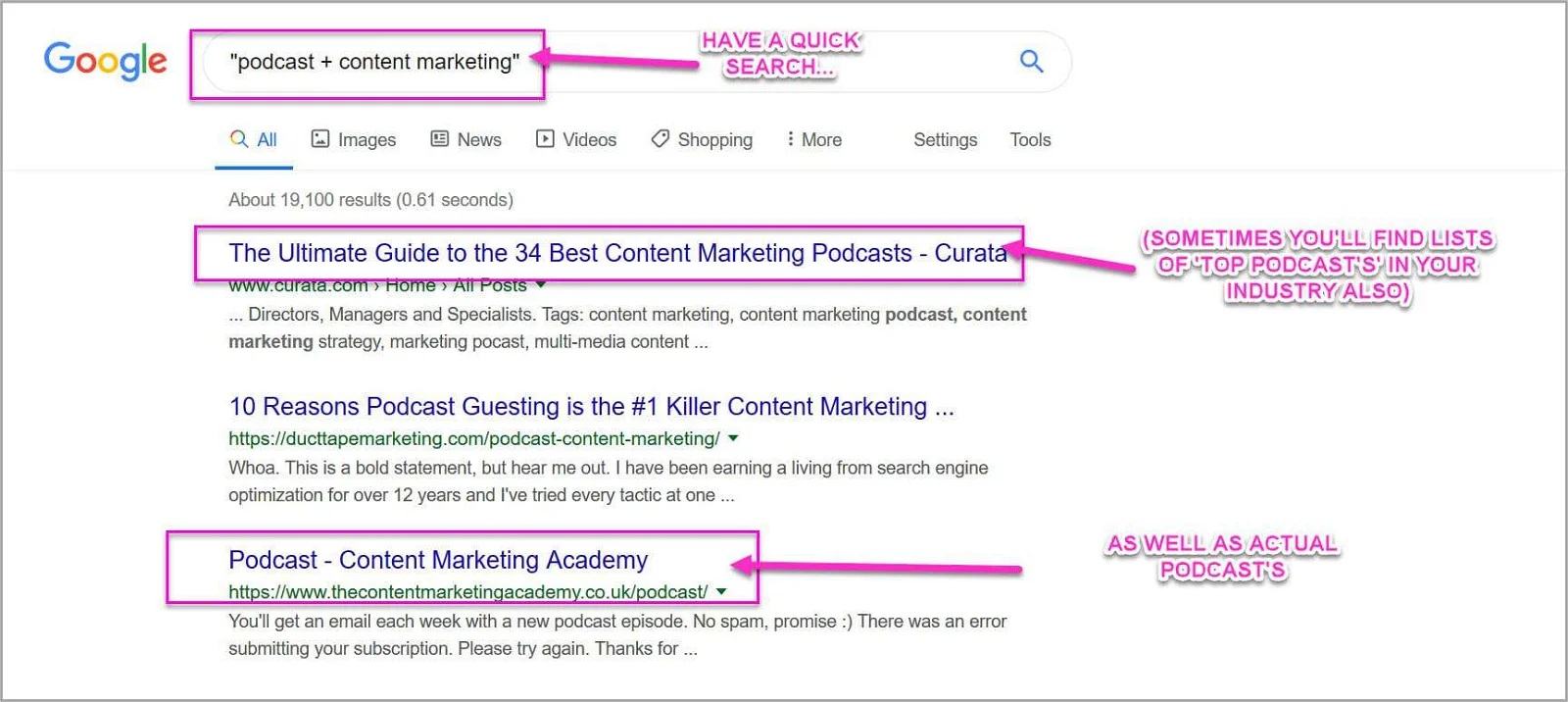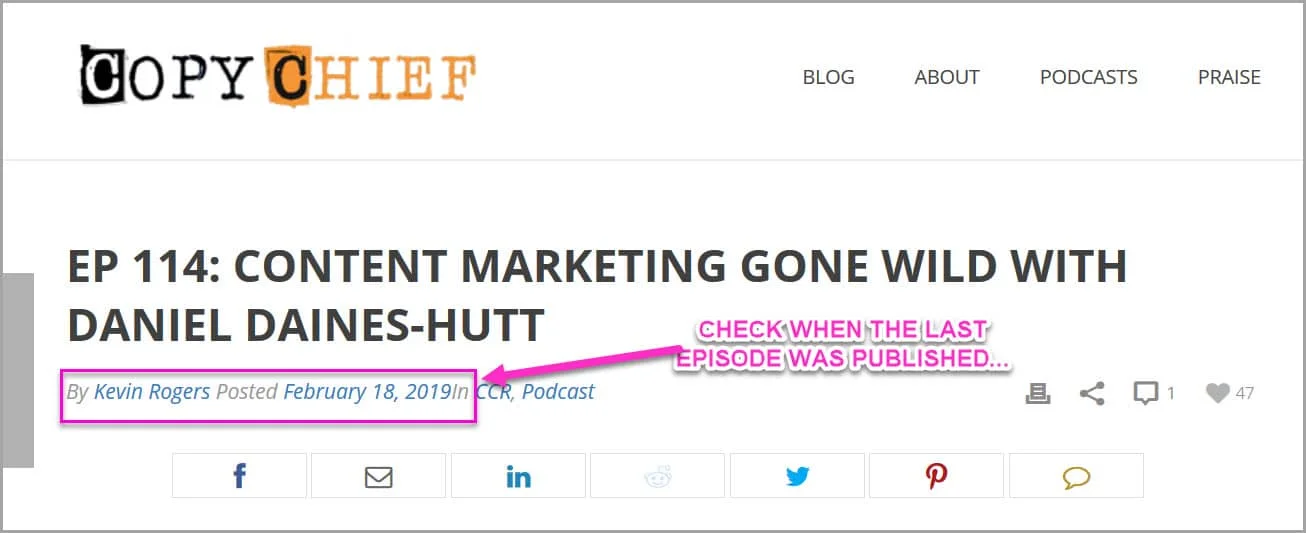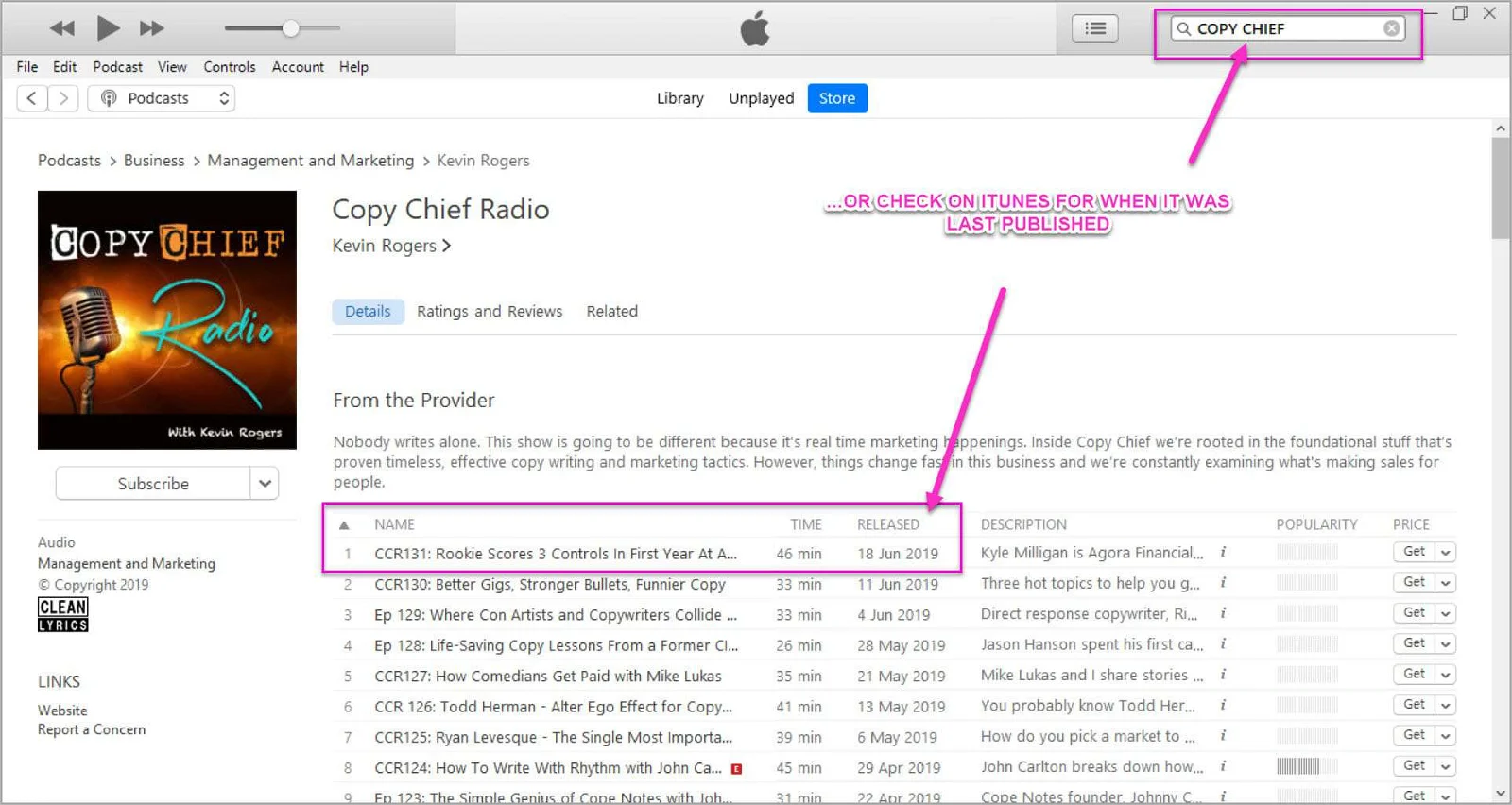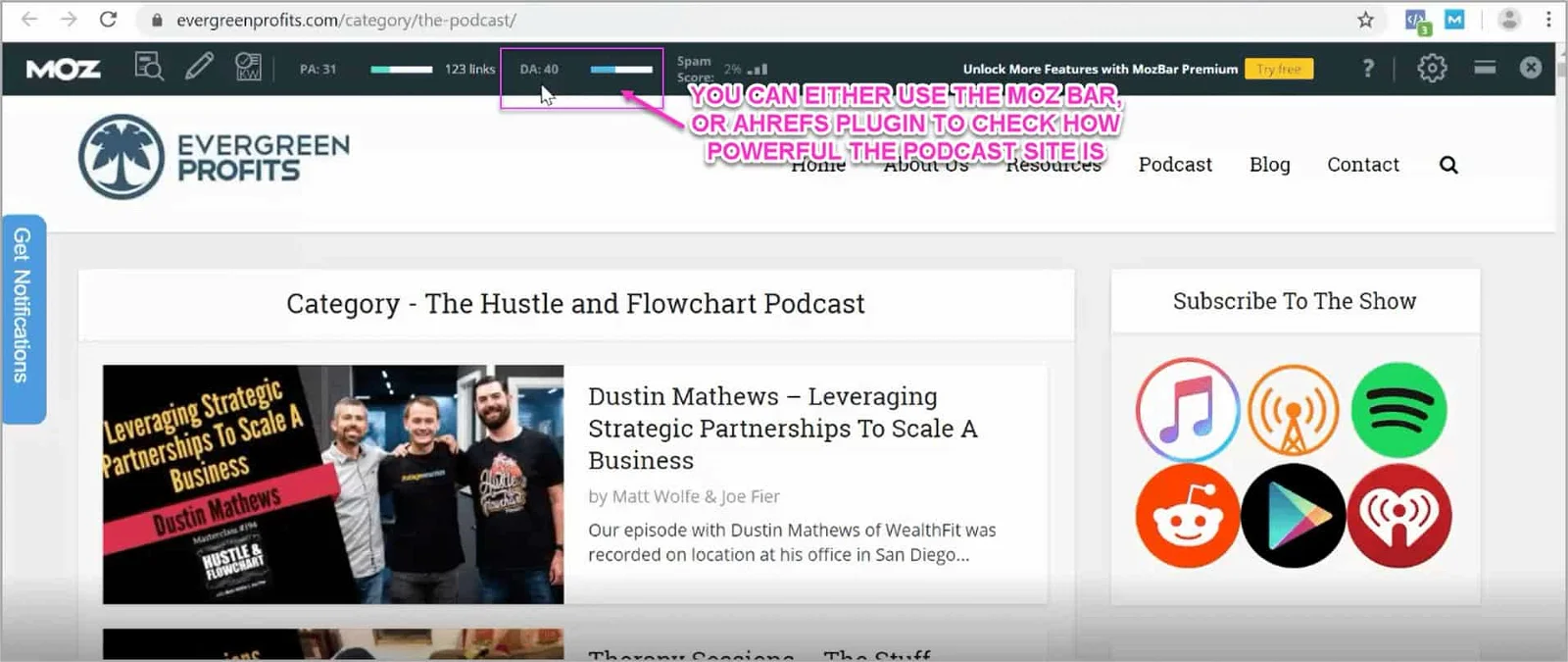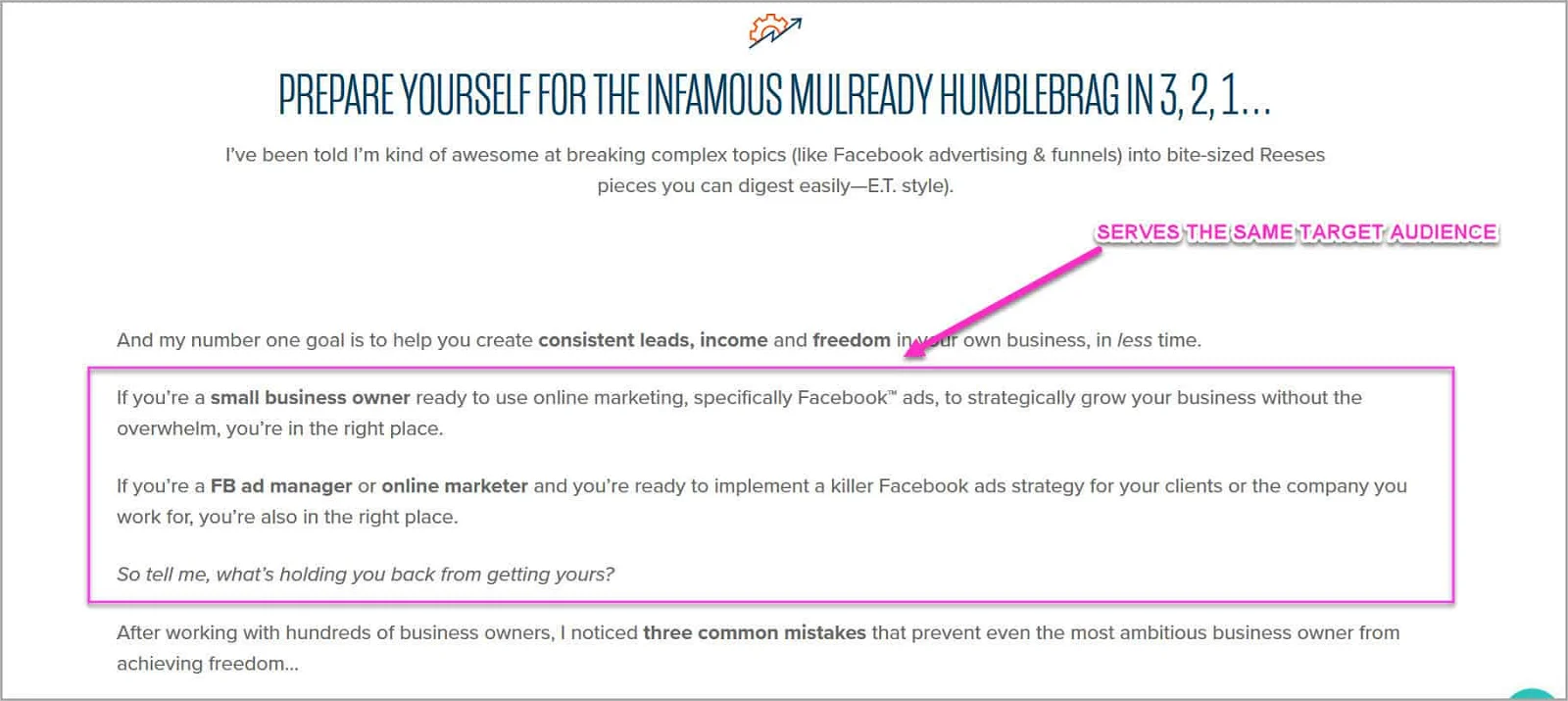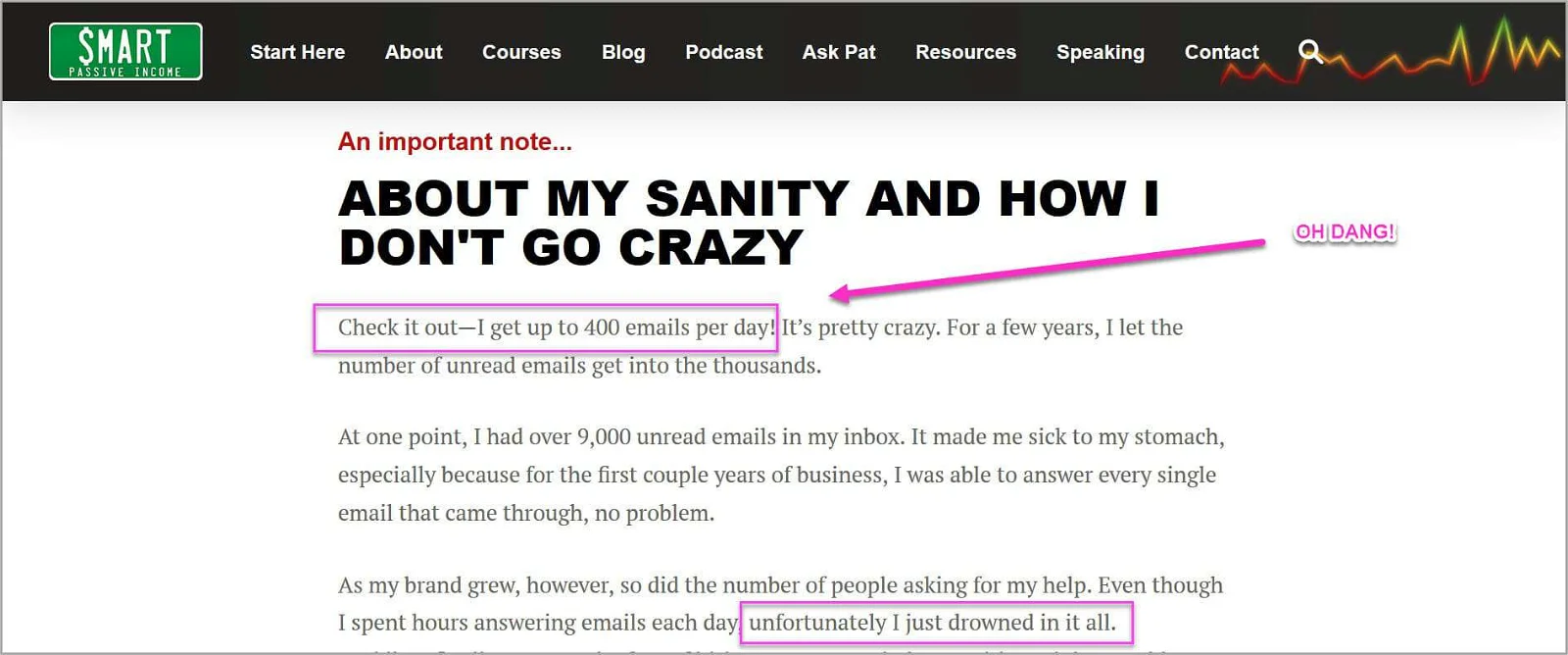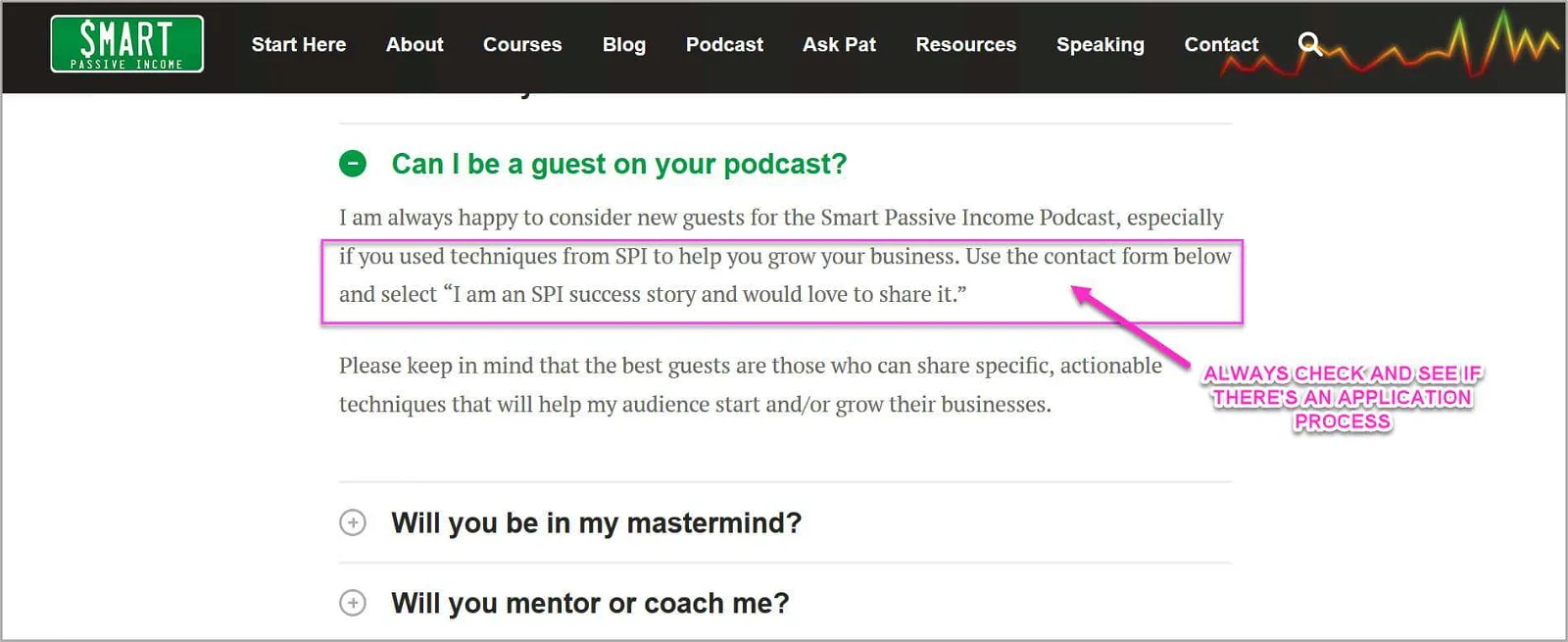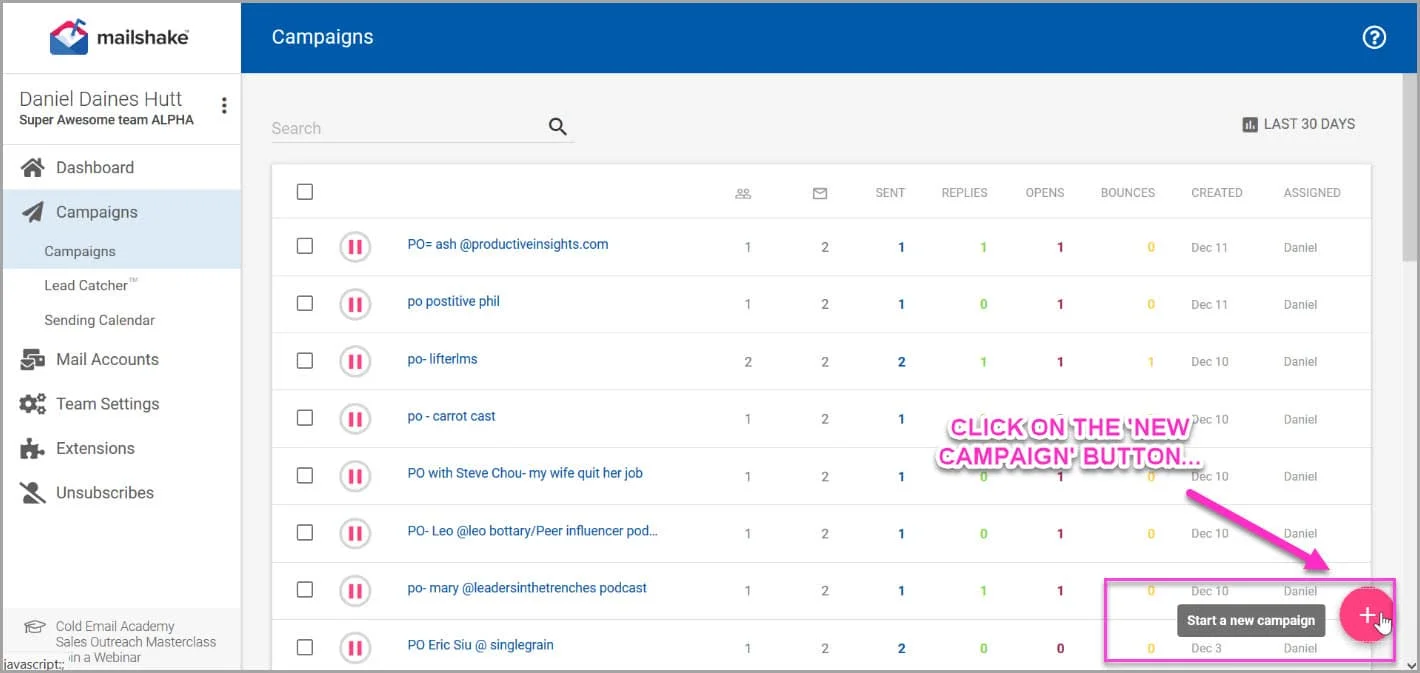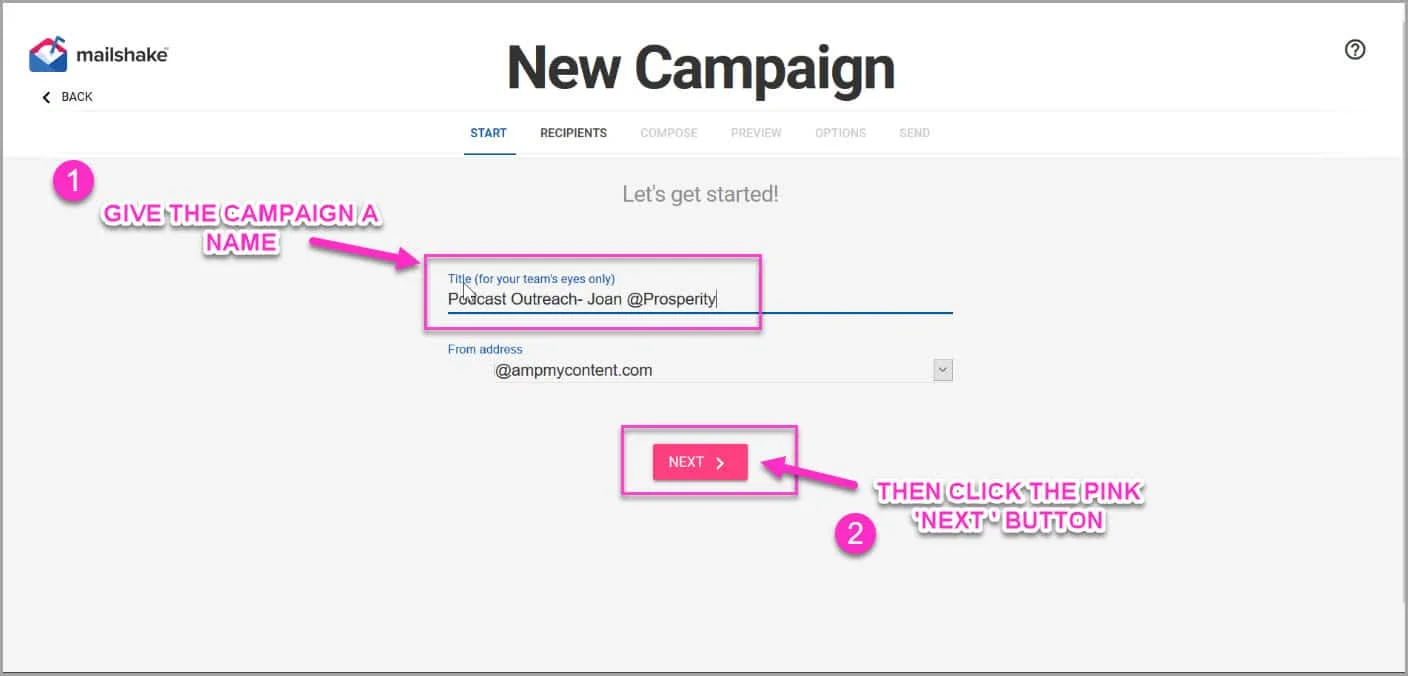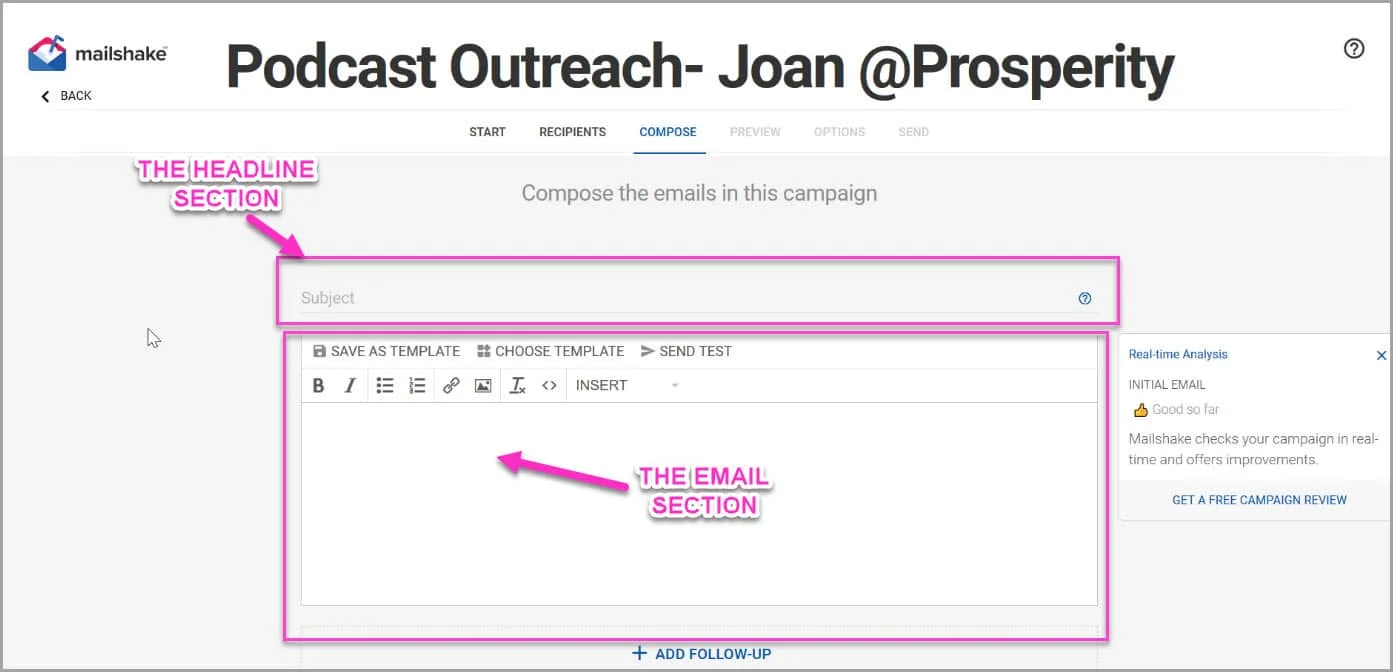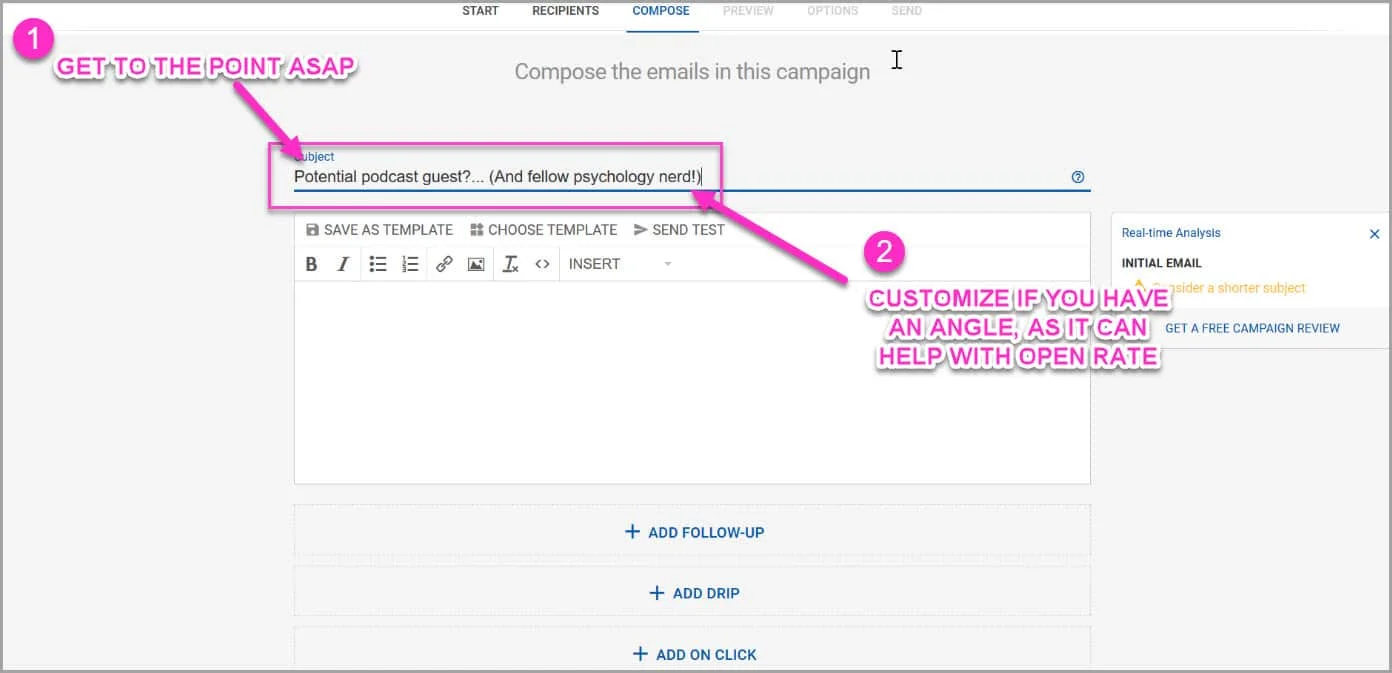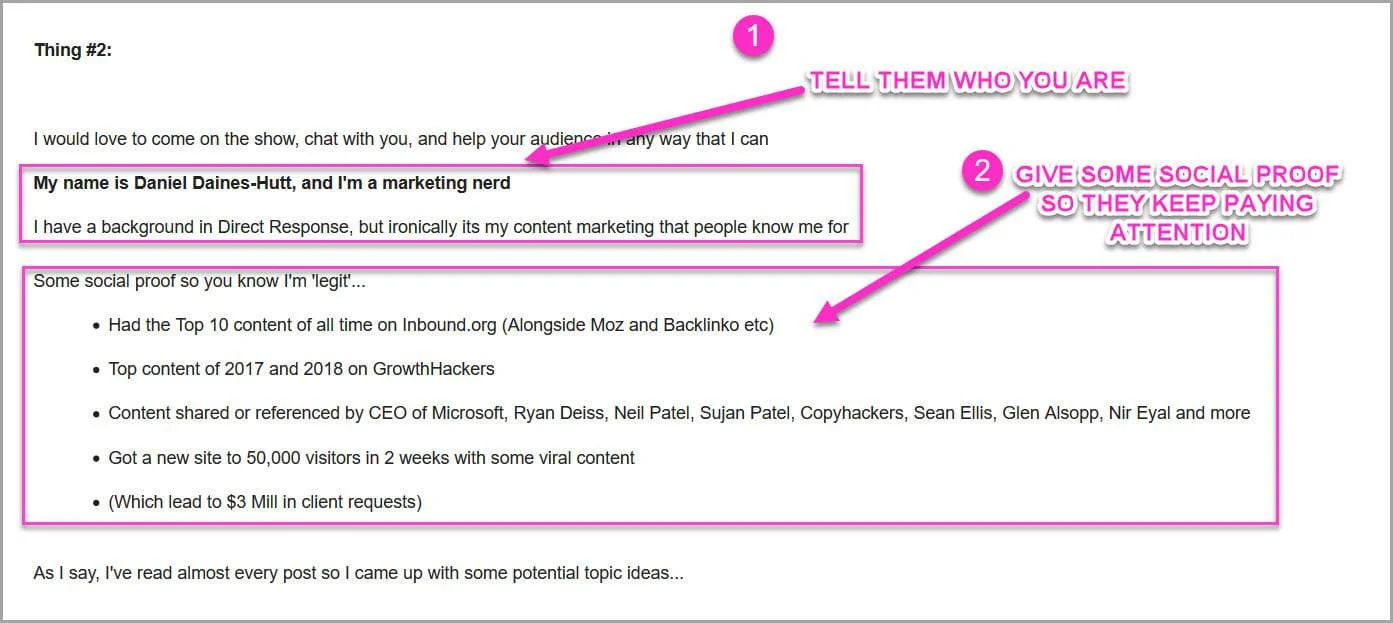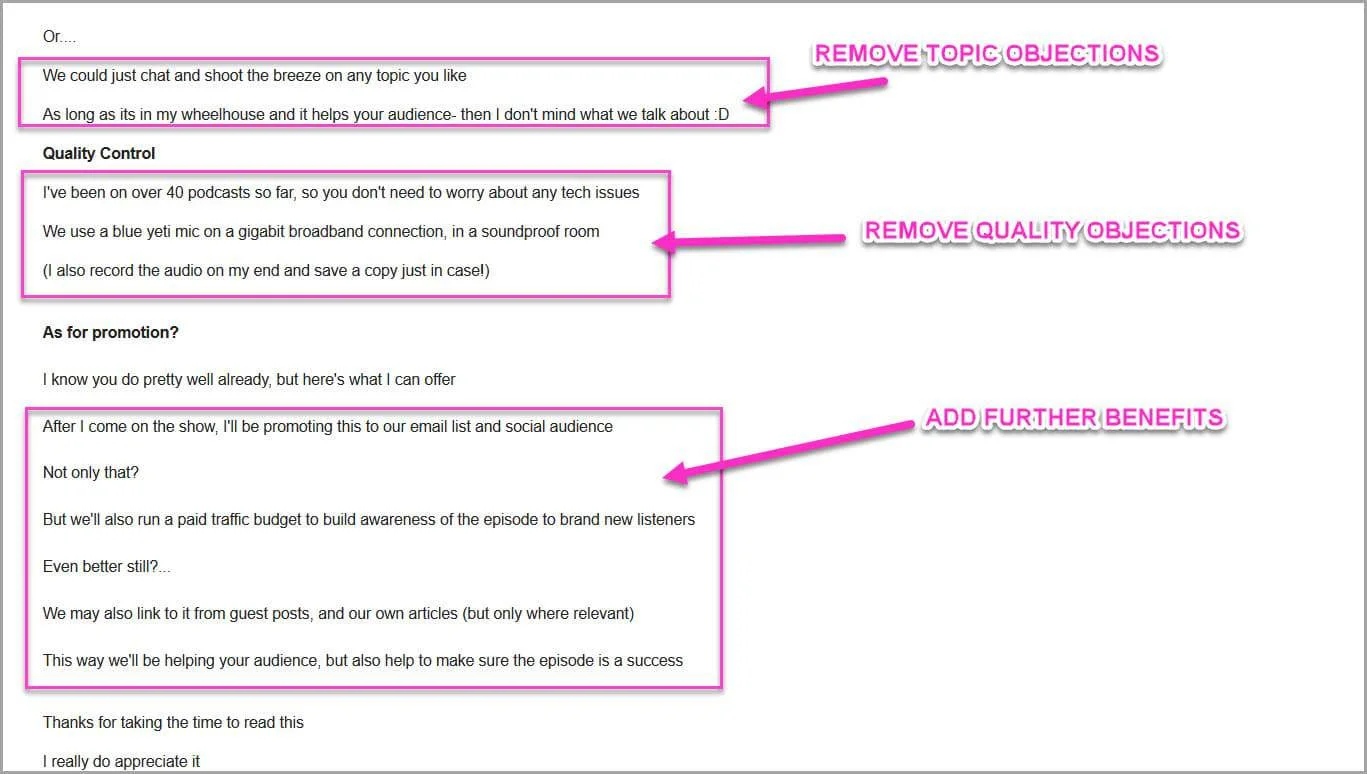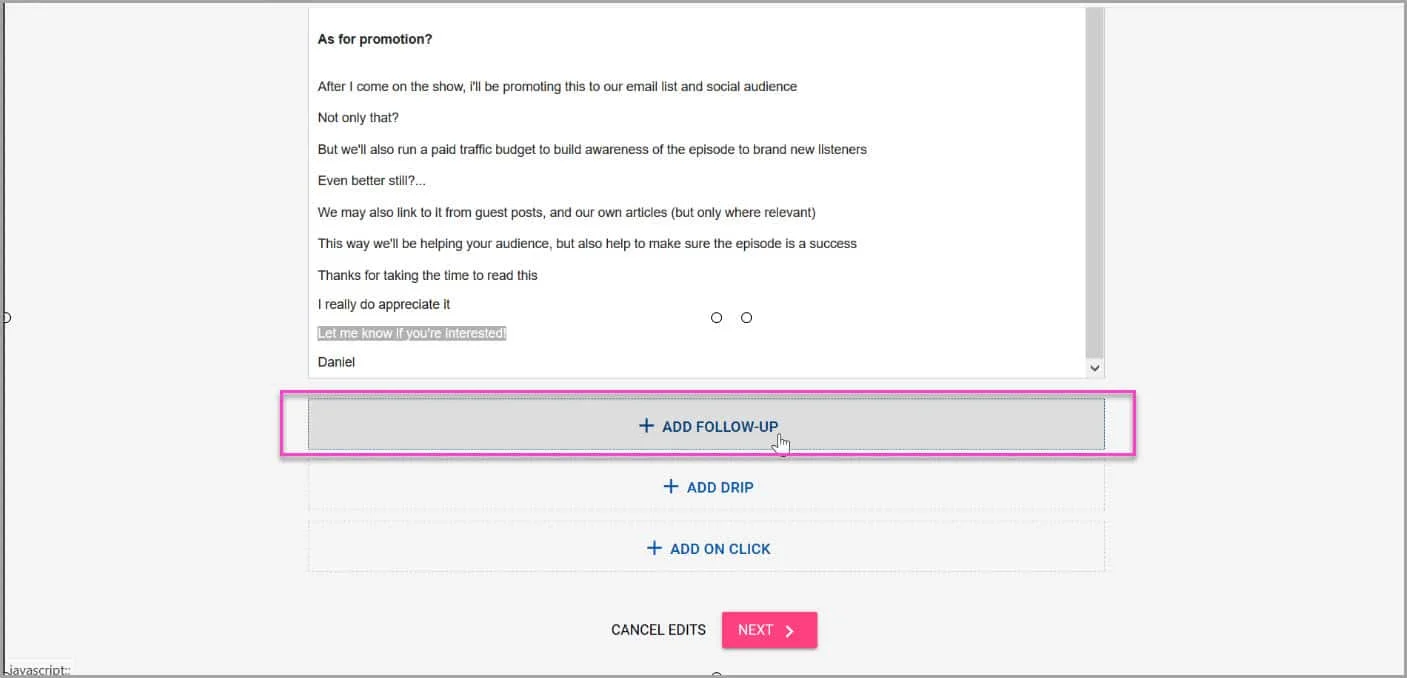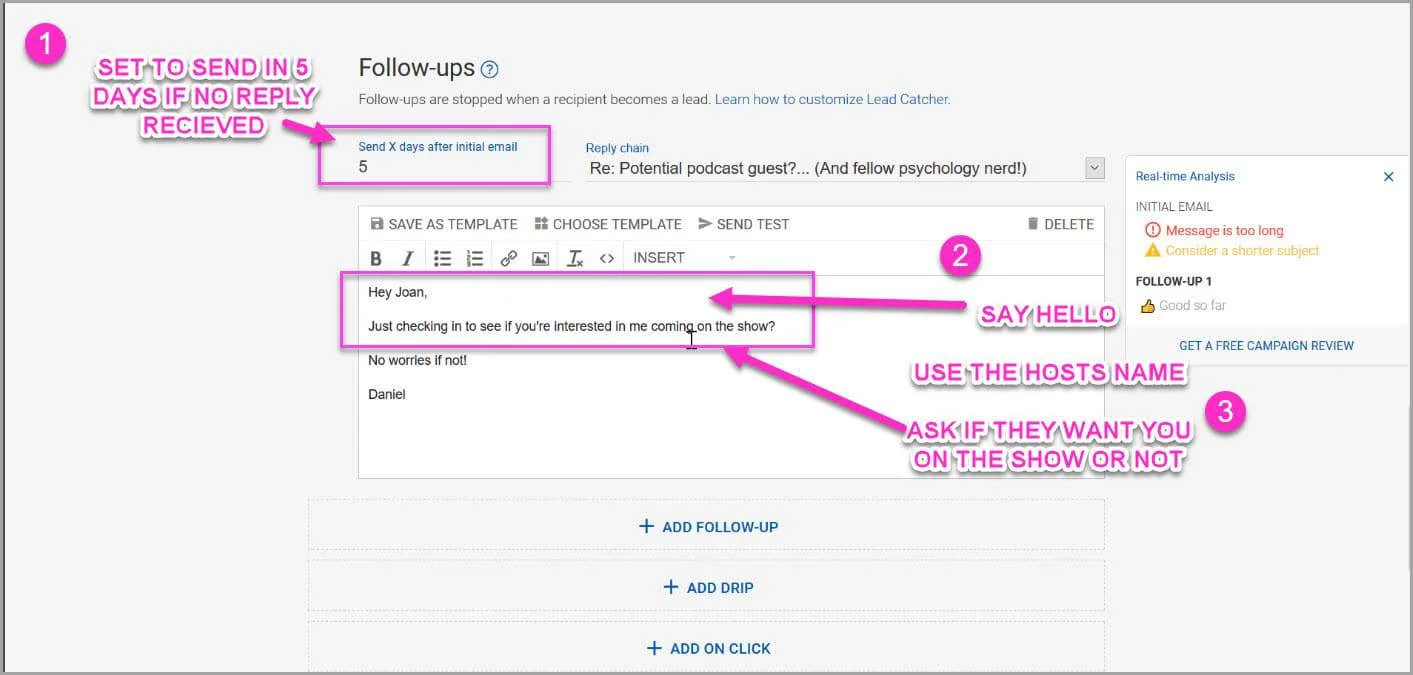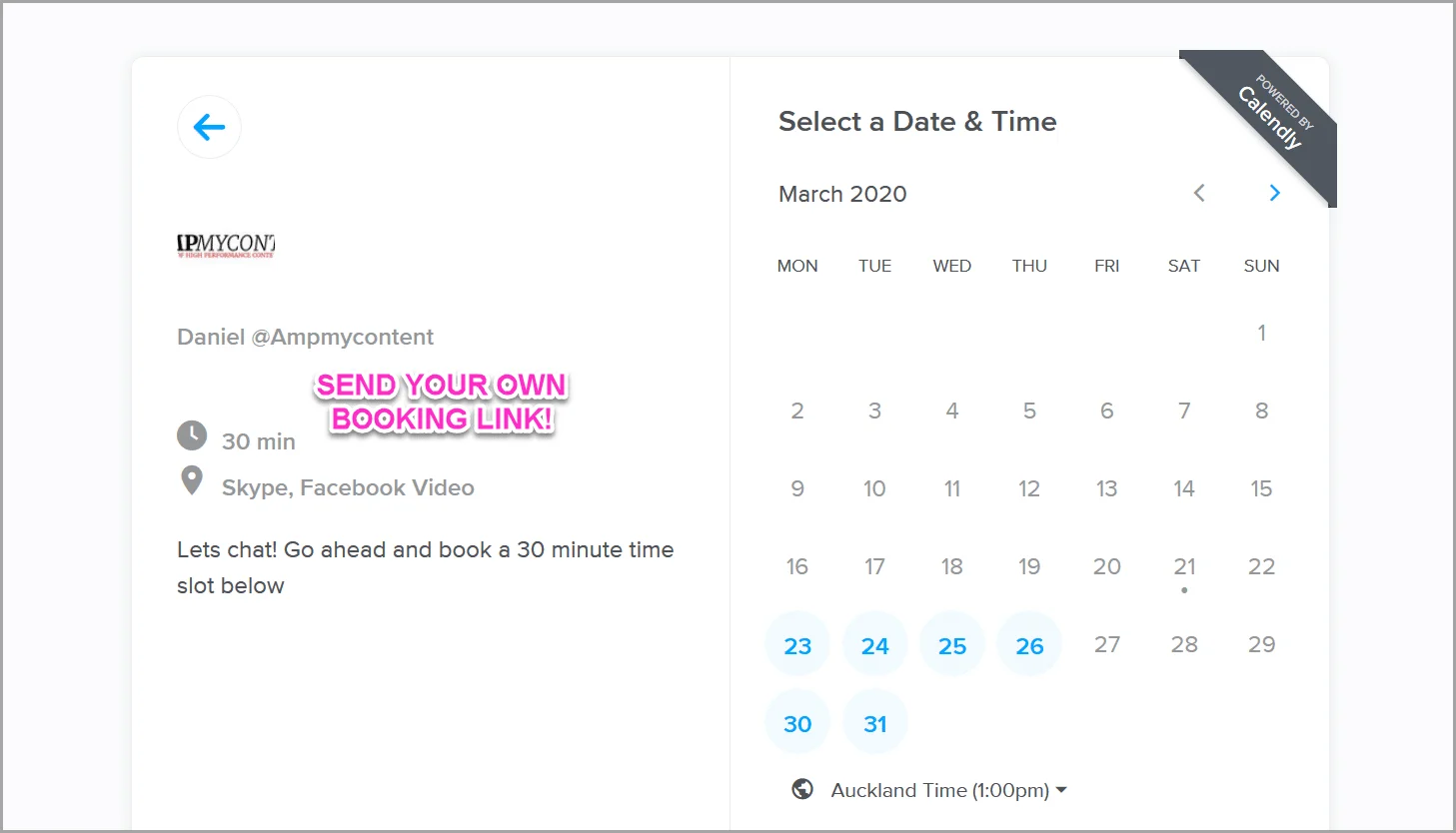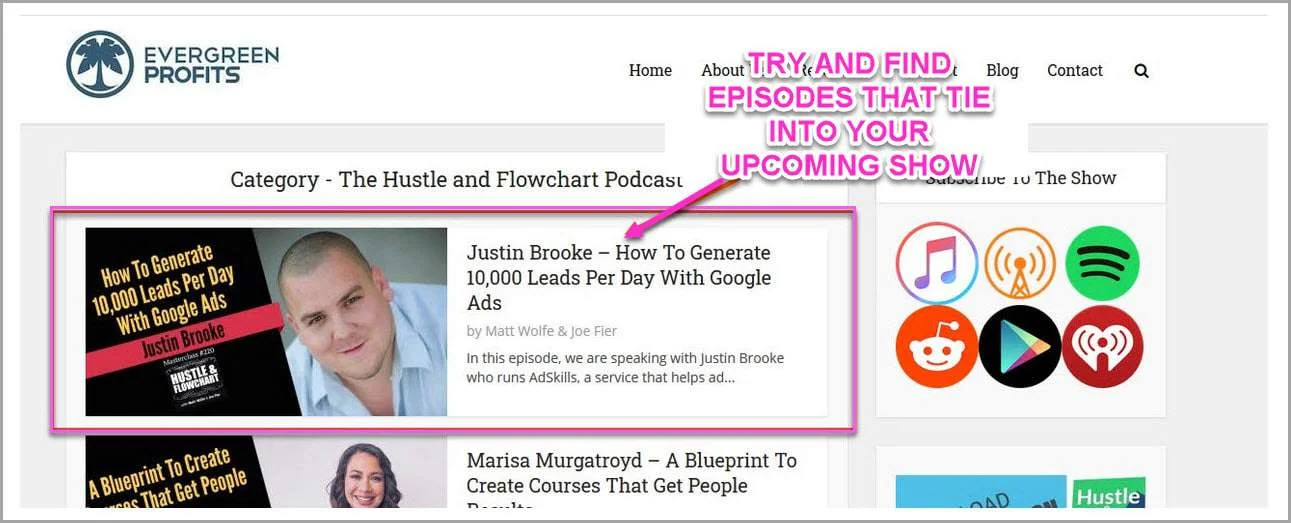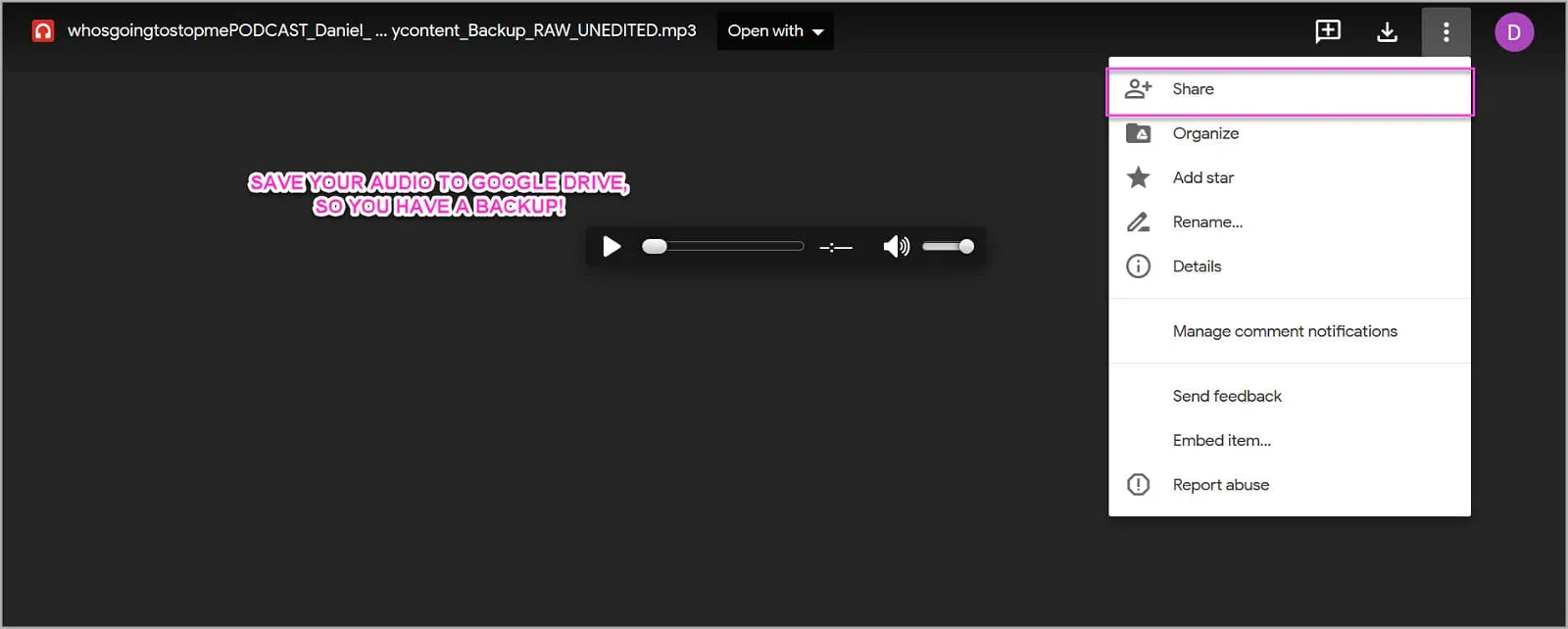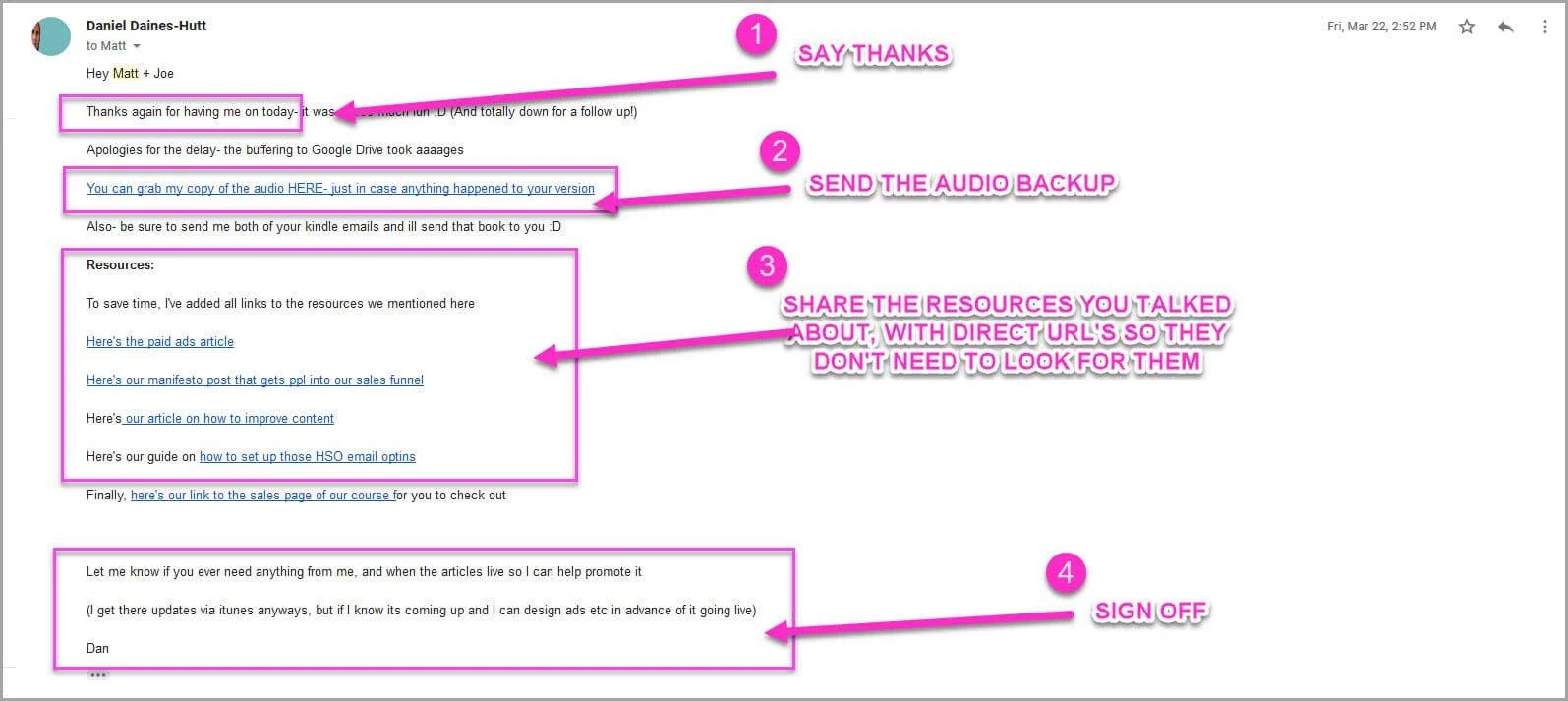48 Million…
That’s how many people listen to podcasts each and every week.
It’s a huge marketing channel, and the best part?
You don’t even need your own show to take advantage of it. You can simply pitch the host, be a guest, and get in front of their audience.
But how do you get on them?
What should you say?
Should you be paying to get on?
And how do you make sure that the episode is a success and not a flop?
Simple…
You can try the perfect podcast guest process.
Designed to help you get on shows and make the most impact with your podcast appearance, this process has helped me go from a brand new website, to speaking on authority shows in just 90 days.
In this guide I’ll walk you through it all step-by-step.
Everything you need to know to get rid of pre-show nerves, drive traffic, raise SEO rankings and how to be one of the top downloaded episodes, even if you’ve never been on a podcast before…

So What Is Podcast ‘Guesting’ + How Does It Work?
Its as simple as it sounds:
You get on shows and chat about a topic in your industry.
It could be about something new and trending, or it could be an evergreen topic and your unique point of view.
Maybe you want to talk about a case study so you can attract clients?
Maybe you have a book or product to promote?
Maybe you have your own podcast but want to grow your listeners?
Or maybe you just want to break down an article that you’ve written before- but tailor it to a new audience?
It’s so easy to do but unlike other marketing methods, the benefits keep stacking up:
- It helps you to distribute your content on a huge scale.
- It’s a great way of clustering content around a topic that you might already talk about or be an authority in.
- It only takes around 30-60 minutes to record an episode, but builds trust, authority and powerful backlinks. (Far easier and faster than guest posting, and easier to build a rapport with the listeners)
So you don’t just get initial traffic from the show, but ongoing organic traffic from Google also!
Better still?
The process is super simple:
Step #1: Find potential podcasts
Step #2: Pitch the show
Step #3: Record the episode
This works even if you’re a brand new blog in a super competitive industry.
Keep reading to learn how…
How We Got A 90% Success Rate Cold Pitching Podcasts
So a little backstory.
Ampmycontent is a new marketing blog that focuses on content promotion.
Our goal is to teach you how to market your content, so that it drives results.
(aka how to get more from it)
The only problem?
The content marketing space is a *little* competitive…
Yeeesh!
Over 4 billion results!
Even when you niche down, its still pretty rough…
The good news is that me and my partner do have some experience at getting traffic.
The main issue?
Our site was only a few weeks old!
We knew that we needed to make an impact if we were going to stand out in our industry, and so our first article was a huge guide to paid content promotion
The Results So Far…
Before we break down the process, let’s have a quick look at the results
We launched the article on our new site back in October.
It started to gain early traction from influencers, but we knew we needed to promote that article if we wanted to get long term traffic from it.
We started reaching out to resource pages and telling them about the article, but it felt a little hit or miss.
(We might only hear back from 2/100 sites)
We knew this wasn’t working well enough but we had done a few podcasts and they were going well.
Not only were the links really powerful, but the time investment from pitch to link was lower, and the conversion rate was higher!
That’s when we decided to double down, and so we started pitching podcasts to chat to their audience about our article topic.
That’s when things went a little crazy…
In just 90 days we were on over 60 different shows.
And these were not small podcasts either…
We’re talking companies like Co-Schedule, Active Campaign, Copy Chief and more
Why care?
Because these podcasts have huge audiences and authority in our industry
Not only that?
These shows had an average Domain Rank of 50+
(Domain Rank is a scale of 1-100 and describes how powerful a website is, in terms of SEO)
Heck…
Some were even higher than that
That’s a DA 84 backlink for less than an hours work!
Why care?
Well you need backlinks to go up the rankings in search engines right?
The more powerful your site, the higher you go up the rankings, and the more traffic you get.
Most people don’t realise, but not every link is equal.
The more powerful the link, the higher you jump up the ranks.
And because the links we so good?
It meant that we went from a DA ZERO website to a DA 40, in just 3 months
Crazy right?
Most sites take YEARS to get a Domain Rank of that size, and some never reach it.
This means that they never see any real traffic from search engines.
But within just 90 days of being a podcast guest and talking about our content, we started ranking our article and getting free ongoing traffic from Google.
Better still?
Once those shows went live it lead to requests from other podcasts to be on their show also!
This meant more links, and access to other audiences.
It didn’t end there either.
Suddenly CEO’s and business owners would reach out to try and hire us, all from listening to the podcasts…
Not bad right?
And we did this without having to pay to be on there.
(Some shows will charge thousands of dollars for you to be a guest)
I don’t know about you, but I don’t fancy paying $1,000 to $20,000 per episode!
And so we didn’t spend a dime.
In fact?
We did it all with just a few cold emails and a little research.
Pretty cool right?
So now that you’ve seen the results this can get, lets walk you through each step.
Or if you want to fast track your results and don’t want to read?
Well we have an entire video training program on how do everything in this guide and more, for just $7.(Down from $57)
You can check that out here, or follow our guide below…
Step #1: Find Podcasts To Guest On
Start off by creating a list of potential podcasts that you could guest on.
Go ahead and open up a spreadsheet, and then start adding the podcast URL’s that you find in the next steps.
You want to try and find around 150 or so.
(The more you can find early on, the better your chances at finding a good fit when you start to filter them down)
Let’s show you how to find them:
Search iTunes
Head over to iTunes and search for podcasts in your industry.
Simply enter your industry keyword, and then go through the shows.
Be sure to check the new and noteworthy also, as they can be easy to get on, and sometimes part of larger websites
Add them to your spreadsheet, and then lets find some more…
Search Google
Another easy way to find podcasts?
Head over to Google and search for:
“podcast + industry keyword”
Not only will you find shows, but you’ll usually find blog posts that are reviewing the top podcasts in your industry.
Simply go through them and add them to your list…
Reverse Engineer Competitors Who Guest On Podcasts
Here’s a sneaky way to find podcasts you might not have heard of.
Go back into Google and search for
“podcast + competitor site” OR “podcast + influencer name”
This will help you find shows you might never have thought of.
Easy right?
Go ahead and add them to your list also.
Now it’s time to filter those results…
Filter Your Results
Want to know how we get such a high success rate when pitching podcasts?
Simple
We filter them so that we only pitch the right people.
Open up your spreadsheet and start working through each of the podcasts that you’ve found.
You’re going to work through them one by one…
Do They Meet Criteria?
The first thing to check is if the podcast is still running!
(It’s pointless to pitch it if they don’t even record anymore right?)
There are 2 ways to find this out:
You can either go to the podcast page and look for when it last published an episode…
Not every podcast will show their publish date
If that’s the case, head across to iTunes and enter the podcast in the search bar…
(iTunes will always have the release date next to the episode)
As long as the show is up and running, its time for the next filter…
Is The Link Worth The Effort?
Now this is more of a quality control check for those SEO minded in the audience.
As a rule of thumb, I try to only go on podcasts where the DR is above 20.
You can use the ahrefs or Moz toolbars to check the DA of each show.
(You can download them from the links above)
Then you simply open up the podcast URL, and it’ll show the domain strength in the toolbar.
However…
If the DR is less than 20, don’t immediately rule them out.
Why?
Because some podcasts are pretty bad at link building, but have huge audiences.
(We’ve seen shows with a DR 5 website but 50,000 monthly listeners)
Other shows might be brand new with no audience or rankings BUT from looking at their work, they might have the potential to grow huge one day.
So its dealers choice here:
If you think the episode will be worth the effort, or you’re just interested in getting on shows, then carry on and perform the next check…
Do They Have Your Audience?
This is a HUGELY important check
Why?
Because its pointless going on a show where you can’t drive traffic from it.
A simple way to check this is to:
- Look at their previous content and episodes/guests.
- Look at their blog content.
- Check their home page and about page.
Who is their audience and who do they serve?
Important:
They don’t have to be your perfect audience, but there does have to be some overlap
i.e they might be a content marketing show and you want to talk about SEO, so there’s a good fit.
As long as they pass all these criteria then its time for the next step…
Step #2: Pitch The Podcast
Here’s the most important thing I can teach you about sales, persuasion and conversion
It’s not about you.
It’s ALL about them.
It doesn’t matter if you have the best product or service in the world, or even if its free-you have to make it all about the other person.
Which is why when it comes to your pitch, you need to take the time to find what matters to the host.
Take the time to find some way of connecting and benefiting them.
Because if you can do that?
Then they’ll almost always say yes…
Find The Angle
How would their show benefit by featuring you?
Having you as a guest, or creating content is not enough.
Instead you need to be looking for:
- How it helps them
- How it helps their users
- How it makes them look good
- How it will affect them
- How simple it will be, etc
Look for some kind of connection if possible.
Even if it’s as simple as you agreeing with a similar belief or idea.
If you can show that you pay attention, it’ll really help you stand out.
So now that you have an angle, it’s time to apply…
How Do You Apply?
A super quick check that most people miss.
Some shows will have specific methods of how to apply. Maybe a contact form etc.
It’s vital that you check for this BEFORE you send them an email.
Why?
Because some of these guys get thousands of emails a month:
This means you might get lost in the noise of cold emails, or worse?
It can look like you couldn’t be bothered to put in any effort!
Not great for a first impression right?
You can usually find the podcast guest application form on either the ‘podcast’ page, or on the ‘Contact Us’ page.
If they have one, then simply fill out the submission form and then jump to the next step below.
If not, then don’t worry!
All you need to do is find their email, and then pitch them using the process we’re about to share.
You can find the hosts email using a free tool called Hunter.io
It’s another toolbar extension.
Once it’s installed, simply give it a click, and it’ll show you what emails it finds for that particular website.
Easy right?
Once you have their email, it’s time to write your pitch…
Pitch The Show
Now you could just email them from your regular email account, but let’s show you a better way.
We use Mailshake for all our cold email pitches.
Why?
Because it helps improve your outreach results…
How?
- It keeps track of emails previously sent, so you don’t email the same person by accident.
- It runs an AI smart filter to let you know if your email seems spammy, and offers improvements.
- It allows you to set follow up automation’s, based on whether they read your email or not.
Pretty cool right?
Go ahead and create a new campaign by clicking the pink button in the corner.
A new page will load up.
Give the outreach email a name so that you remember it, and check that the ‘from’ email is correct.
Then click the next button.
A new page will load asking for the email address.
Paste the email you found earlier into the box, and then click the import button.
Important:
You could in theory just copy and paste the email of every podcast you find in here, and just mass email everyone.
DON’T DO THIS!
Why?
Because taking the time to personalize each email will get you far better results.
Trust me on this.
Emailing 150 podcasts and getting on 50 of them, is far better than emailing 1500, getting on 50 and annoying 1,450 other people in your industry…
Make sense?
Once you click the import button, it’ll load up the campaign builder:
So let’s write your email…
Write The Headline
Keep the headline nice and simple.
“Potential podcast guest?…” is short and to the point, and will usually get opened
Customize it if you found a connection or angle, otherwise just get right to the point and let them know that you are interested in being a guest on their show.
The Introduction And Angle
The start of the email is super important.
Why?
Because you’ll either get them interested, or lose them.
Stick to the following:
- Say hello
- Use the host’s name
- Bring up the connection angle
- Let them know that you want to be on the show
(You would be surprised how many people do cold outreach and don’t even bother to get the host’s name right)
Now that you have their attention, you need to keep it…
Why Should They Pay Attention To You?
These guys get pitched all the time, so it’s vital you make an impression fast.
How?
All you need to do is simply:
- Tell them who you are, and then
- Give some social proof that connects with what you BOTH do
Remember:
It’s not about bragging.
It’s about building trust with the host and showing that you are worth their time.
It doesn’t need to be epic either. It just needs to be enough that they take you seriously.
Now they’re ready for your episode pitch…
Make It Easy To Say Yes
What’s one of the biggest problems with creating content?
It’s thinking WHAT to create.
In this section, you’re going to pitch a few different episode ideas.
This:
- Removes the effort of them having to come up with a show idea
- Gives them a few to choose from
- Helps you to direct the conversation towards your article topic 😉
Try and tie each idea to your angle, or to ways that the topic could benefit them.
This makes it real easy for them to say yes.
Remember:
The easier it is for some to do something, the more likely they are to do it.
Especially if you remove any objections they might have in advance…
Remove Objections And Stack Benefits
It’s time to remove any potential objections, and add on a few extra benefits.
It’s real easy:
- Remove any topic objections.
- Remove any tech worries.
- Give some additional benefits of how you’ll help the show to succeed.
By now it’s a no brainer not to have you on their show.
So there’s just one more thing to do…
The Call To Action
Ask to go on the show!
So many marketers miss this that it’s crazy!
If you don’t ask someone for something then they won’t do the thing!
So simply ask to be on the show, or at least to reply to you
Congratulations!
You now have an awesome cold pitch
Now it’s time to make sure it doesn’t get missed…
Automate The Followup
OK so these podcasters get a LOT of pitches.
This means their days can be a little hectic, and sometimes your message gets lost
Or worse?…
They LOVE your pitch but then they get distracted and forget to write back to you.
So what can you do?
Easy!
Set up an automated follow up email in Mailshake
Scroll down below the campaign builder, and click on the ‘add follow up’ button.
This will open up a mini campaign builder.
Start off by adjusting the timer to 5 days.
(This means that the follow up email will only be sent, if they don’t reply before 5 days have passed)
Pretty cool right?
Now you just need to write the email:
- Say hello
- Use the host’s name
- Ask them if they are interested in having you on the show
- Sign off
Because the initial pitch was good, you don’t need to write anything else.
Click the pink send button and then wait to hear back from them.
Easy right?
So here’s what to do when they say yes to your pitch…
Get The Booking!
Full disclosure?
Most sites will love your pitch and then send you a podcast booking confirmation email.
You click a link and then pick a time that suits the both of you to record the show.
The thing is?
Not every show is this organised…
I’ve been on some HUGE podcasts that don’t have a booking system, and so guess what happens?
You get a lot of back and forth emails trying to figure out a time that works until too many things get in the way, and you lose the opportunity.
Not great right!
If you hear back from the host and they haven’t included a booking form, then you can fix this easily using a tool called calendly.
It’s a free booking tool that most of the hosts use, but you can get your own account also.
(It’s also fantastic for sorting out time zones and availability, and connects to Google calendar etc)
Go ahead and create your own account.
(It will look similar to this)
Then email the host back:
- Say thanks for the opportunity to be on the show, and ask if they have a booking link for you to organise a date.
- Then add your own booking calendar link ‘just in case they don’t have one’, and let them know it’ll sort out time zone issues etc
This way the host can either send you a link, or book in on your calendar.
Boom!
So now that you have the booking locked in, it’s time to record the episode!…
Step #3: Record The Show
So here are my top podcasting tips.
Not only will they help the recording go smoother, but it helps the episode to do better with the audience.
(And gets you invited onto other shows for more links and traffic)
How To Be A Great Podcast Guest
So what makes a good podcast guest?
It’s not just about knowledge or having a good story for their audience.
It’s all about making the show a success!
From promoting the show, to making the appearance go smoothly, and the best way to make this happen?
Preparation!
The mark of a great podcast guest is when they know their content AND the audience that they’re talking to.
Why?
Because then they can tailor the conversation to best suit the listener.
Make sense?
It’s real simple to do this…
Prepare In Advance-Research
Go ahead and listen to a few other episodes of the show, before you record.
(Especially episodes that might talk about your upcoming topic)
This will help you to understand the audience’s level of awareness of your topic, as well as the interviewer’s style of questions.
Why care?
Because then you can adjust how nerdy or deep you get with your content.
Better still?
You can reference previous episodes and guests.
This makes the host look good, and it also adds more value to the episode…
Prepare In Advance – Content
Another way to stand out?
Have notes of WHAT you want to talk about, and how it ties into your article.
Why?
Because if you can reference the content in the episode, then you can build links to it 😉
Also?
It helps introduce the audience to your content and drive them to it!
It’s real easy to do.
I look at my audience research and then I ask myself a few questions:
- Where is the audience now, and what are all the things they need to understand to be ready for my topic?
- What specific things do they need to know about my topic?
- What order do they need to learn this in?
- What do I want to cover in the episode?
- What do I want them to do after listening to the episode?
By mapping this out I remove any anxiety about being on the show, and I can create a journey for the listener, with a clear call to action for them to take at the end.
There’s one more piece of prep that’s vital to your success…
Don’t Let The Show Fail
The worst thing that can happen after recording a podcast?
It’s when the audio dies, breaks or gets lost!
Now some podcaster’s are pretty cool and will re-record the show.
(It’s not the best option, but it does means you can still try and get that link and build your audience)
But others?
Some are so busy they just don’t have time, and that sucks.
So What Can You Do?
You record a backup copy of the audio for yourself. That way if the host’s audio breaks, you still have yours!
There are a whole bunch of tools you can use for this.
On a Mac, you can record for free with QuickTime.
(Just be sure to turn the internal mic on so that it records the hosts voice also)
If you use a PC then you can use a tool called Camtasia.
Once you have your tool set up, check it all works, and that it records correctly.
(And check again the day of recording in case there’s a software update)
Then?
Just hit record before your answer the call!
Be A Standout Guest
OK so the show is recorded, you referenced content and other episodes AND you recorded a backup.
Great job!
By now you’re already looking good in the host’s eyes.
Want to stand out further and GUARANTEE you get your backlink?…
Of course you do!
All you need to do is make the host’s job easier.
How?
Easy…
Edit And Save Your Audio
Go ahead and edit your audio backup.
Remove the before and after conversations, and then save the audio to Google drive.
This means that if the host has to use your copy, they don’t have to cut out all the pre-show audio, and they’ll love you for it 😀
Then?…
Send Them The Assets
The worst thing about podcasting?
All the work AFTER the recording is finished!
The host has to edit, upload, and find all the URL’s to content that you talked about during the show.
Talk about hard work!
Stand out and make sure you get the links to the right content, by simply sending all those URL assets to the host.
Makes sense right?
By making their job easier, you stand out and get those links.
Go ahead and:
- Email the host and say thanks
- Add a link to the Google drive audio that you just edited
- Add links to all the content and resources you mentioned (so you get the link to your article)
- Thank them for their time
- And click send!
Now you just need to wait for their email so you can promote the episode when it goes live.

Now It’s Your Turn…
So there you have it.
A step-by-step process for pitching podcasts to get on shows and grow your audience.
Can you see how powerful this is?
Podcast guest speaking is one of the fastest ways to build links and grow your SEO rankings. It’s how we went from a brand new site to being on some of the biggest shows in the industry.
You can do the same.
Want to make sure that every episode is a success?
Then be sure to get our #11 step recording checklist by clicking the yellow box above. It walks you through everything you need to do, prep and say to make the most of every episode that you guest on.And don’t forget:If you want to fast track your results, then we have an entire video training program on how do everything we just showed you and more, for just $7.
